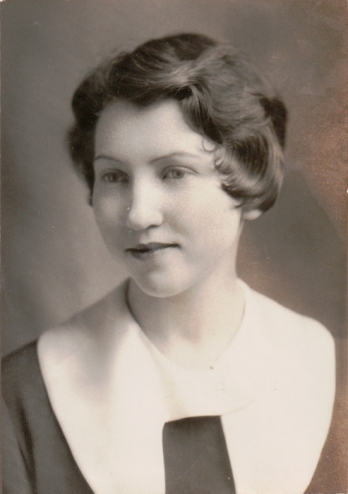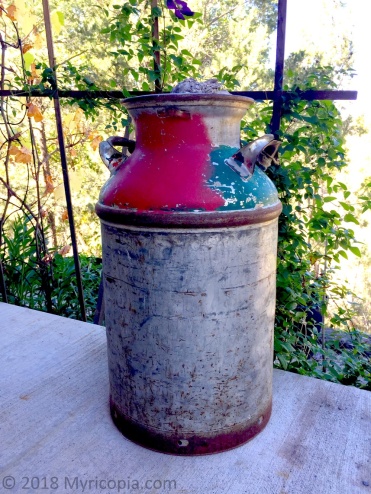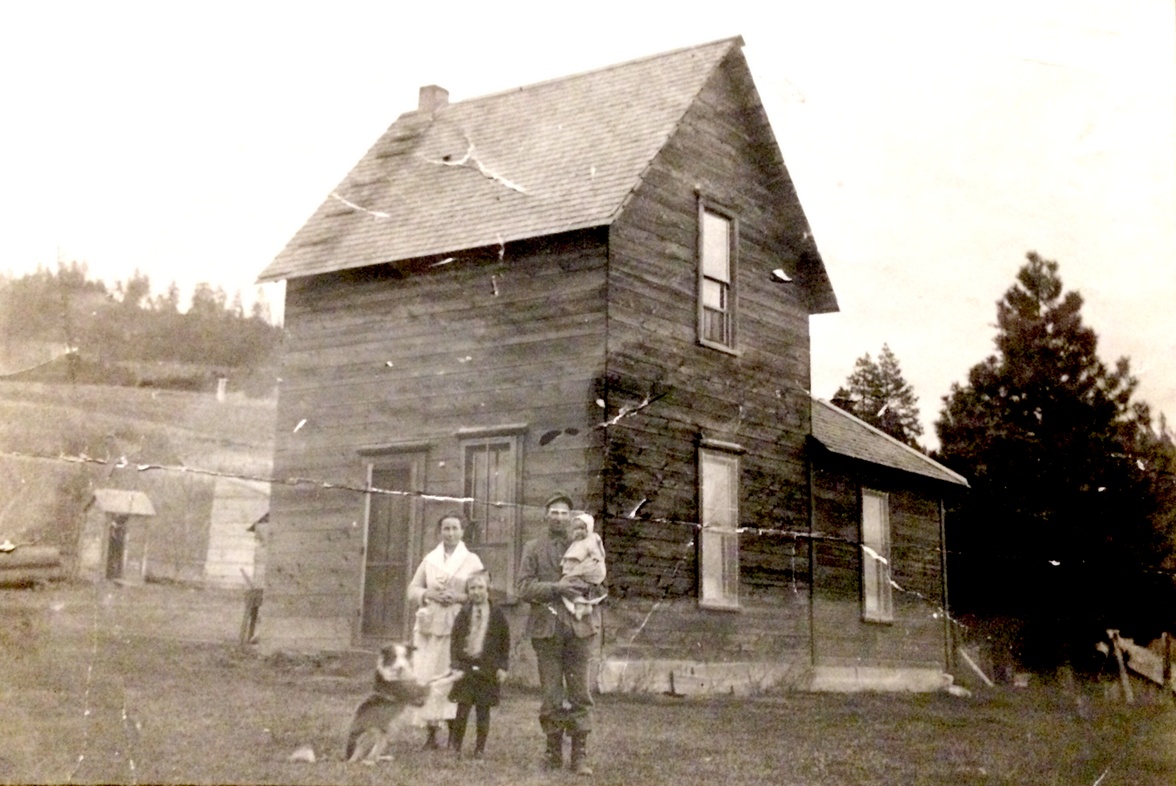Week 39: #52 Ancestors – On the Farm
By Eilene Lyon
My grandmother, Clare Ransom Davis, was born on the Davis family farm about six miles from Moscow, Idaho, in 1914. She was the second (and last) child of Clara Pearl Ransom and Sterling Price Davis. Grandma wrote a story about her father that I will share in a later piece.

In 2000, my aunt did an oral history interview with Grandma. The cassette tape copy she gave me degraded badly over the years, so I was unable to do a verbatim transcript. But I was able to take detailed notes about each story she told.
Not long after Clare was born, her mother moved with the two girls into town during the school year. Grandma loved the farm, but she only spent summers and some weekends with her father until she was 14 years old. These are a few of her recollections.
I Remember the Farm
By Clare R. (Davis) Smith, edited by Eilene Lyon
My father had to stay by himself in the winter time to take care of the animals, while mother lived in a house in town where she had four college students boarding (freshman boys).
In spring, after grade school on Friday nights, I would walk part way toward the farm and father would meet me on his saddle horse or come into town with a buggy to pick me up. I would ride behind him on the saddle horse. I would spend the weekend with him to keep him company and I loved it on the farm.
We had a two-story house with only one room upstairs. In the summertime, it was too hot to sleep inside, so father set up two tents, one for men, one for women.
The farm’s income came mainly from alfalfa. The University of Idaho had to buy bales of hay for their stock and they were quite particular, but they usually bought ours.
When the alfalfa was ready to cut, they put it in shocks out in the fields. When it was time to bale, they moved it to the baler on slips made of boards hauled behind the horses. They were no more than 12 inches off the ground.
When the slip was ready to be hauled, it was loaded until it was like a regular haystack. When full, it was pulled into a baling site and a pole was put across the front, supported by other side poles and the slip was pulled through to unload so it wouldn’t have to be done by hand.
That was a busy time. They would come in at noon to rest and would be very tired. Father would lie on his side. I was very young, probably not more than two, and thought if Dad was lying on his side that his hip looked like a dandy place to sit and so I sat there and listened to the conversations. I didn’t understand them all, of course, but I was part of the picture. I enjoyed those lunch times.
When I was older, one of my jobs on the farm in the summer was to take lunch to the workers in the field, so they wouldn’t have to quit so long to go to the house. I would also take a jug of water tied to the saddle horn. I was riding off to the field with my load and came to a country gate. I had to get down off the horse and open the barbed-wire gate to get the horse through.
As I was closing the gate, the horse decided not to wait and ran off down to the field with the sandwiches and water. I was disgusted, but not crying. When Dad saw the horse, he thought I was being dragged by it. He grabbed it and turned it around so fast, thinking I was hurt. It didn’t even break the jug.
We had a good many pets on the farm. All the pets lived outside or in the barn. We had a nice collie dog and a family of cats, all black. A little black cat found out my father went to the barn twice a day to milk the cows. Dad had been known to squirt some milk in their faces so they could lick it off and they thought that was a fine idea.
So, when it was milking time, my father got his clean bucket and headed off toward the barn where the cows were and those black cats lined up in a row behind him and they all trooped off to milk the cows. The cats walked with their tails upright and a little kink in the end, so they were a sprightly little troupe.
The End


Sterling Price Davis died on January 1, 1933. His older daughter, June, and son-in-law, Paul Wickward, bought the property and ran it as a dairy operation. They reared their four children on the farm. It was sold in the 1960s, but the new owners took an interest in the history of the family. Many Wickward family reunions have been held there.
I visited Moscow for the first time in 2013 and enjoyed touring the farm (much of the land has been sold off) along with one of the Wickward’s adopted grandsons, who lives in Moscow. The owner gave me a souvenir milk can to bring home.

I plan on visiting the farm again next year, when the Wickwards will have another reunion. It will be the first time I will meet many of these cousins. Some I have communicated with by email or phone, but not met face-to-face. I look forward to making my own memories about the Moscow farm.
This slide show has some of the photos I took at the farm in 2013:
Feature image: The Moscow farm with Clara, June, Sterling, and Clare Davis. (Courtesy B. Herbel)

Love the pictures. The house is remarkably attractive, isn’t it, and the old cars have become pieces of art. Love Idaho, although we never got as far north as Moscow. We did get to drive through the Sawtooth Mountains when my husband was based at Mountain Home, and enjoyed a monthly drive into Boise. I got interested in genealogy there when a woman talked about finding a Civil War ancestor!
LikeLiked by 1 person
What’s funny is that in my mind I never pictured the farm being on this hill covered with evergreens and all the rolling land around it. I imagined all farms being flat like in the midwest! Idaho is a beautiful state. I was so glad to visit Moscow, given all the family history there, but I really had never been before 2013. Thanks for reading!
LikeLike
Enjoyable and interesting. Every time I hear Sterling Price I think of the drunk cat on Rooster Cognurn.
LikeLiked by 1 person
Never heard of that character. My gr-grandpa was named for Gen. Sterling Price of the Confederate Army (and later governor of Missouri). I named my dog Sterling, since I don’t have kids to name after my ancestors. 😉
LikeLike
The cat in the john Wayne movie Rooster Cogburn is named after your grandpa. The cats full name was general sterling price.
LikeLike
LikeLiked by 1 person
I probably shouldn’t introduce the General to my dog!
LikeLiked by 1 person
That is so amazing that you have that old testimony and these pictures (the dog in the first picture is excellent lol). And how wonderful to visit in person! Such a neat family history! 🙂
LikeLiked by 2 people
I’m really grateful my aunt had the idea of interviewing her mother. She was getting Alzheimer’s by then.
LikeLike
Loved reading your Grandmother’s story. The farm is beautiful, not what I was imagining while I was reading!
LikeLiked by 1 person
It wasn’t anything like I imagined it would be, either, having never been to that part of Idaho before then.
LikeLiked by 1 person
Beautiful area and interesting posting. Times have sure changed. 🙂
LikeLiked by 1 person
The story and the photos are all wonderful. Being a cat lover, I of course love the cat stories. And the photo of the shoes!!!!!!!!!!!!!!! Wow!
LikeLiked by 1 person
The shoes are a hoot. That’s not all they’ve found, but that’s another story.
LikeLiked by 1 person
Should I stay tuned for that revelation?!
LikeLiked by 1 person
Certainly!
LikeLiked by 1 person
My, you have an interesting family. I love old family photos, especially the many that I used in my book: https://www.amazon.com/gp/product/B00K1L3XMK/ It is a genealogy novella that celebrates hard work in building the American West.
LikeLiked by 1 person
I didn’t buy a copy, but haven’t read it yet, just the excerpt.
LikeLiked by 1 person
Amazing first hand account! The pictures also tell a story
LikeLiked by 1 person
I am fortunate to have stories like these. But I always wish I had more!
LikeLike
Wow–beautiful photos of the farm. And those shoes from the walls! Great old stories. I’m always struck by how many families lived apart; now we would deem it unthinkable to live apart from a spouse–or to split up siblings. Even in my mom’s years, she spent a year or two with relatives, as her own family didn’t have enough money for one more kid.
LikeLiked by 1 person
I think maybe that’s happened a lot in the past. I’ve seen cases where widows had to essentially indenture their very young children. I think it worked more like foster care, but had to be painful for the child to be separated from mother.
LikeLiked by 1 person
So enjoyed reading this post with the farm life descriptions. Enjoyed the photos too… Amazing that the family get togethers are an ongoing event. Wonderful how you did a transcript from a cassette of your grandmother telling her story… I did an interview many decades back with my grandfather on a cassette, but sadly with the amount of times I have changed countries and my nomadic lifestyle it got lost with so much else, in the shuffle.
Peta
LikeLiked by 1 person
Hi Peta,
Thanks for stopping by to read Grandma’s story. I wish I’d done a better job with the transcription – the tape deteriorated over time to where you just couldn’t hear it at all. So don’t feel bad about the one you lost. If you remember anything from it at all, just jot it down. I’ve only ever been to one reunion, but it sure was worthwhile!
LikeLike
What wonderful memories you have documented here. My grandparents owned a small dairy farm, and I spent all of my summers with them. The house always seemed so big, and the barn was always neat, tidy, and had white washed walls. A large neighboring farm bought it and incorporated it into their property. I stopped once and talked to the new owner who had known my grandparents. We had a good conversation, but I couldn’t get past how it looked. It had always been white with black trim, but now it was a kind of hideous yellow, and when I asked if I could look in the barn, he respectfully declined because he said it was stacked floor to ceiling with junk. I prefer the picture I have in my mind. 🙂
LikeLiked by 1 person
That’s a shame that the new owners haven’t quite the same vision of the property as your grandparents. The person who bought my grandmother’s house improved it substantially. Even though it’s different (yellow, not white) it looks quite nice. I haven’t seen the inside, though.
LikeLiked by 1 person
So glad you were able to save some of the stories from those tapes. I liked the old shoes found inside the walls.
LikeLiked by 1 person
So funny, those shoes. Sterling hid his empty chewing tobacco cans in the walls, too, so Clara wouldn’t find them in the dump and know he’d been chewing!
LikeLiked by 1 person